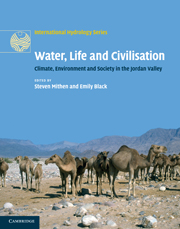Book contents
- Frontmatter
- Contents
- List of figures
- List of tables
- List of contributors
- Acknowledgements
- 1 Introduction: an interdisciplinary approach to Water, Life and Civilisation
- Part I Past, present and future climate
- Part II The palaeoenvironmental record
- Part III Hydrological studies of the Jordan Valley
- Part IV Human settlement, climate change, hydrology and water management
- Part V Palaeoeconomies and developing archaeological methodologies
- Part VI Society, economy and water today
- 24 Current water demands and future strategies under changing climatic conditions
- 25 Water reuse for irrigated agriculture in Jordan: soil sustainability, perceptions and management
- 26 Social equity issues and water supply under conditions of ‘water stress’: a study of low- and high-income households in Greater Amman, Jordan
- 27 The role of water and land management policies in contemporary socio-economic development in Wadi Faynan
- 28 Political discourses and public narratives on water supply issues in Amman, Jordan
- Part VII Conclusions
- Index
- Plate section
- References
28 - Political discourses and public narratives on water supply issues in Amman, Jordan
from Part VI - Society, economy and water today
Published online by Cambridge University Press: 26 April 2011
- Frontmatter
- Contents
- List of figures
- List of tables
- List of contributors
- Acknowledgements
- 1 Introduction: an interdisciplinary approach to Water, Life and Civilisation
- Part I Past, present and future climate
- Part II The palaeoenvironmental record
- Part III Hydrological studies of the Jordan Valley
- Part IV Human settlement, climate change, hydrology and water management
- Part V Palaeoeconomies and developing archaeological methodologies
- Part VI Society, economy and water today
- 24 Current water demands and future strategies under changing climatic conditions
- 25 Water reuse for irrigated agriculture in Jordan: soil sustainability, perceptions and management
- 26 Social equity issues and water supply under conditions of ‘water stress’: a study of low- and high-income households in Greater Amman, Jordan
- 27 The role of water and land management policies in contemporary socio-economic development in Wadi Faynan
- 28 Political discourses and public narratives on water supply issues in Amman, Jordan
- Part VII Conclusions
- Index
- Plate section
- References
Summary
ABSTRACT
In its National Water Master Plan 2004, the Jordanian Government stressed that the first priority is to meet the basic needs of the people. On the other hand, water is pressingly needed for agricultural activities as well as in the industrial and tourist sectors. Unlike many cities in the developing world, 98% of households in Amman are connected to the water supply network. However, since 1987, the supply of water has been rationed. For most areas, water is now supplied once a week, although the duration of supply varies considerably. From the first, the rationing of urban water reflected not just scarcity but also the dilapidated physical state of the network. In respect of management, from February 1999 to December 2006, the water supply system of Amman was placed in the hands of the private sector company known as LEMA. During this period, the network was comprehensively upgraded and in the winter of 2006, continuous supply was introduced to some 15.8% of LEMA's customers. Following this, some technical experts argue that the entire system should move to continuous supply, both for technical and supply reasons. However, the political will for this does not appear to exist. Based on critiques of extant water policies, and on semi-structured interviews with key informants including different socio-economic groups of urban consumers in Amman, this chapter analyses political discourses and public narratives on urban water supply issues.
- Type
- Chapter
- Information
- Water, Life and CivilisationClimate, Environment and Society in the Jordan Valley, pp. 455 - 466Publisher: Cambridge University PressPrint publication year: 2011
References
- 1
- Cited by



